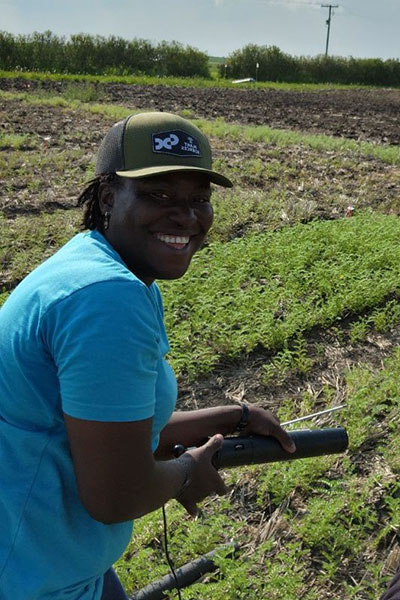Saskatoon, Saskatchewan, Canada
February 5, 2025
As the United Nations prepares to celebrate World Pulses Day on Feb. 10, USask international graduate student Ifedolapo Adebara is investigating the variability of the often-understudied pulse crop’s roots, and whether its special fungus resistance could improve pea and lentil yields.

USask international graduate student Ifedolapo Adebara is studying chickpea roots to improve root disease tolerance in pulses. (Photo: Kira Glasscock)
When PhD candidate Ifedolapo Adebara arrived at the University of Saskatchewan (USask) a year ago and started researching chickpea, even this master’s degree holder was amazed at some of the tools at her disposal.
Jumping into investigating roots in the field, Adebara began using a device that allows her to scrutinize them without pulling a single plant from the ground and allowing her to avoid “destructive” practices.
“We have minirhizotron tubes that we install in the ground at a 45-degree angle with a scanner so we can scan the roots as they grow. It’s shocking,” she said, laughing. “They’re glass tubes, a few metres long and then we are able to put the scanner—because it is not as long as the tube—in at different lengths.”
About a third of the way into the project, Adebara is still gathering information and not yet at the analysis stage. But she can already see interesting things with the naked eye.
For example, different varieties of chickpeas, being analyzed in the same location, can have very different roots.
“Some roots go down while some prefer to stay more at the soil surface,” she said.
“We are trying to see what works better. Is it deep roots that go down to access water? Or is it roots that are fine and get whatever amount of water is present at the soil surface? Which plants have the better yield, at the end of the day?”

Ifedolapo Adebara, an international graduate student in the College of Agriculture and Bioresources, examines roots in a field. (Photo: Submitted)
In the College of Agriculture and Bioresources’ Department of Plant Sciences and supervised by Dr. Maryse Bourgault (PhD), Adebara is originally from Nigeria, where she received her first two degrees.
The first was a bachelor’s degree in plant science at the Obafemi Awolowo University, which she followed with a master’s in crop physiology at the University of Ibadan.
Coming to USask was inspired by her experiences and observations.
“I wanted to explore something beyond the shores of my country, understand how agriculture is being studied, how it’s being run, how to improve food availability generally.”
Her decision was also a result of researching which countries prioritized agriculture.
“I realized that Canada is one of those, and I also realized that the Prairies had a higher level of research in agriculture,” Adebara said. “I already figured out the University of Saskatchewan was my top school when I was searching in Canada. I absolutely loved Saskatchewan. I don’t know why.
“When I was trying to check out professors I could reach out to ... interestingly my professor was one of the people I singled out and I said I would love to work with this person. She is into sustainable agriculture.”
Adebara’s master’s research was on a pulse crop, as well—the cowpea, really a kind of bean. She loves pulses because they provide a wide variety of benefits and said they deserve more research attention.
“Every crop will respond differently depending on environmental conditions,” she said. “However, most of the time, they have the same kind of things they supply, the things we would look out for,” such as adding nitrogen to the soil.
“The roots are understudied compared to the grown plants because we can’t see under the soil while the plants are growing.”
Roots pull in water and nutrients for the plants to grow, and they clearly respond to their environmental conditions.
“Everything you see above the ground is a result of what happened below the ground.”
Which roots translate into better yields must be determined before Adebara can suggest and select for traits and transfer that information to plant breeders.
There is another important angle to her project, which will come once it moves from field to greenhouse: a great mystery is why pea and lentil are both susceptible to a fungus called Aphanomyces root rot, while chickpea is not.
“What are the root differences? Is it that chickpeas have an anatomical or structural trait that prevents them from being susceptible to that particular fungus? What does chickpea have that pea and lentil do not have?” she asked.
“Why do chickpeas act like it’s not really there? It would be a huge help to overcoming this fungus.”
The research is funded by the Pulse Cluster and Bourgault’s Natural Sciences and Engineering Research Council of Canada Discovery Grant.
“The overall project aims to find root traits that can improve drought tolerance, carbon sequestration and root disease tolerance in pulses,” Bourgault said.
At present, it is “next to impossible” for breeders to try and breed for root traits because they are so hard to see and seedling assays are usually not well correlated with what happens later in crop development, she said.
“Therefore, if we were able to identify genes, then it would be much simpler for breeder to include these traits in their breeding program.”
Adebara is motivated by concerns over climate change and future droughts.
“There are dry years. We have to be on top of things to make sure yield does not dwindle. We are looking to improve varieties that can adapt to the coming climate change, dry environments, that can still give us great yield,” said Adebara.
“The other reason is Aphanomyces. It has been discovered as a big problem in the Prairies and there are not completely resistant varieties.”
Losses can be as high as 100 per cent in an Aphanomyces afflicted crop. Even a 50 per cent loss is very worrisome, she said.
“We are trying to help the breeders so they can get rid of the fungi or, if it’s not complete resistance, there is partial resistance and the outcome is not as devastating as it usually is.”
Ultimately, she hopes her research will help Prairie farmers produce good yields, help assure food availability, and keep climate change at bay for pulse crops around the world.